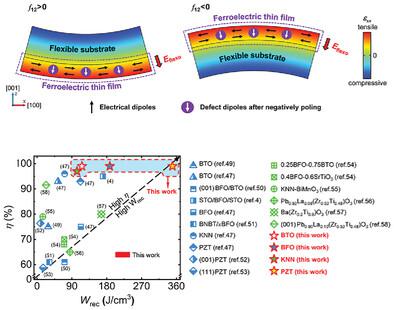当前位置:
X-MOL 学术
›
Adv. Electron. Mater.
›
论文详情
Our official English website, www.x-mol.net, welcomes your feedback! (Note: you will need to create a separate account there.)
Advancing Energy‐Storage Performance in Freestanding Ferroelectric Thin Films: Insights from Phase‐Field Simulations
Advanced Electronic Materials ( IF 6.2 ) Pub Date : 2024-04-18 , DOI: 10.1002/aelm.202400001 Changqing Guo 1, 2 , Huayu Yang 2 , Shouzhe Dong 1, 2 , Shiyu Tang 1, 2 , Jing Wang 1, 2 , Xueyun Wang 3 , Houbing Huang 1, 2
Advanced Electronic Materials ( IF 6.2 ) Pub Date : 2024-04-18 , DOI: 10.1002/aelm.202400001 Changqing Guo 1, 2 , Huayu Yang 2 , Shouzhe Dong 1, 2 , Shiyu Tang 1, 2 , Jing Wang 1, 2 , Xueyun Wang 3 , Houbing Huang 1, 2
Affiliation

|
Advances in flexible electronics are driving the development of ferroelectric thin‐film capacitors toward flexibility and high energy storage performance. In the present work, the synergistic combination of mechanical bending and defect dipole engineering is demonstrated to significantly enhance the energy storage performance of freestanding ferroelectric thin films, achieved through the generation of a narrower and right‐shifted polarization‐electric field hysteresis loop. The recoverable energy storage density of freestanding PbZr0.52 Ti0.48 O3 thin films increases from 99.7 J cm−3 in the strain (defect) ‐free state to 349.6 J cm−3 , marking a significant increase of 251%. The collective impact of the flexoelectric field, bending tensile strain, and defect dipoles contributes to this enhancement. The demonstrated synergistic optimization strategy has potential applicability to flexible ferroelectric thin film systems. Moreover, the energy storage properties of flexible ferroelectric thin films can be further fine‐tuned by adjusting bending angles and defect dipole concentrations, offering a versatile platform for control and performance optimization.
中文翻译:

提高独立式铁电薄膜的储能性能:相场模拟的见解
柔性电子技术的进步正在推动铁电薄膜电容器向灵活性和高储能性能方向发展。在目前的工作中,机械弯曲和缺陷偶极子工程的协同组合被证明可以显着增强独立式铁电薄膜的储能性能,这是通过生成更窄且右移的极化电场磁滞回线来实现的。独立式PbZr的可恢复储能密度0.52 钛0.48 氧3 薄膜从 99.7 J cm 增加−3 在无应变(缺陷)状态下达到 349.6 J cm−3 ,大幅增长251%。弯曲电场、弯曲拉伸应变和缺陷偶极子的共同影响促成了这种增强。所证明的协同优化策略对于柔性铁电薄膜系统具有潜在的适用性。此外,柔性铁电薄膜的储能特性可以通过调整弯曲角度和缺陷偶极子浓度来进一步微调,为控制和性能优化提供了通用平台。
更新日期:2024-04-18
中文翻译:

提高独立式铁电薄膜的储能性能:相场模拟的见解
柔性电子技术的进步正在推动铁电薄膜电容器向灵活性和高储能性能方向发展。在目前的工作中,机械弯曲和缺陷偶极子工程的协同组合被证明可以显着增强独立式铁电薄膜的储能性能,这是通过生成更窄且右移的极化电场磁滞回线来实现的。独立式PbZr的可恢复储能密度



























 京公网安备 11010802027423号
京公网安备 11010802027423号